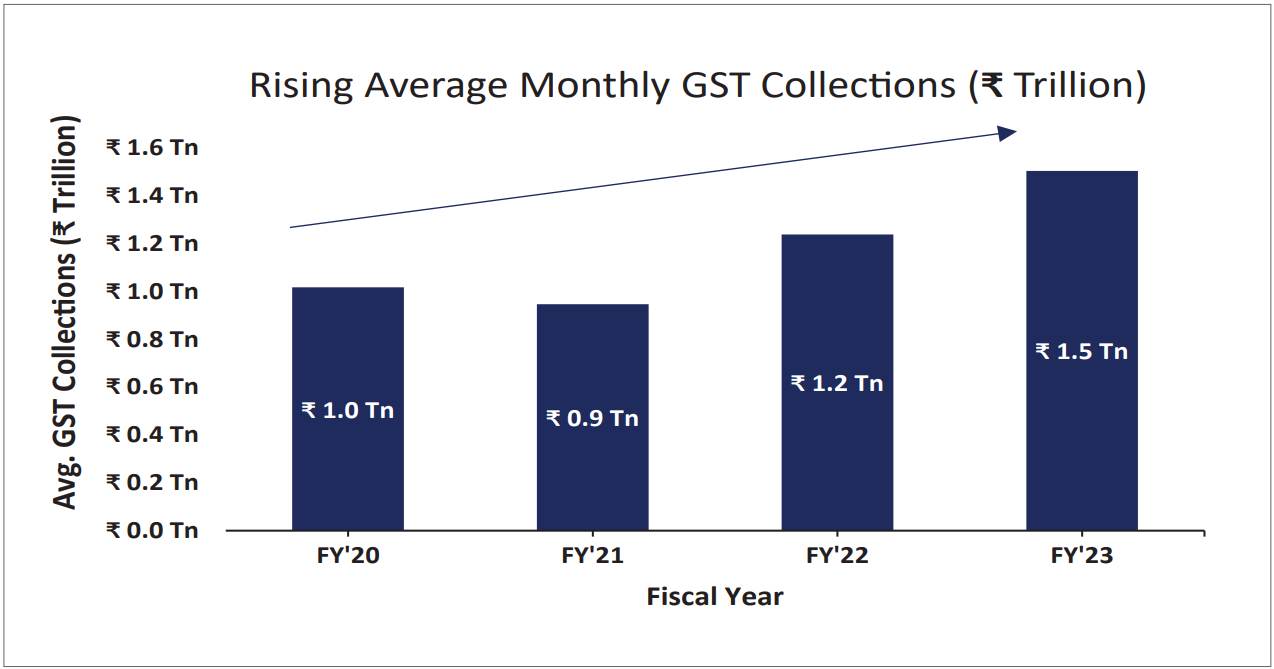
Macro and
Equity Market
Outlook
Equity Market
Outlook
GLOBAL MACRO & MARKETS – Mar 2023
India’s NIFTY index remained flat MoM in March, ending the month
with a MoM growth of just 0.3%, lagging major global indices. MSCI
World index rose 2.8% in March and MOEX Russia led the ascent with
an 8.8% rise. The S&P500 (+3.5%), Euro 50 (+1.8%) and the Nikkei
(+2.2%) rebounded in March despite adverse news flow. Among
emerging markets indices, HANG SENG rose 3.1%, respectively.
BOVESPA (Brazil), fell 2.9% MoM in March. LME Metals Index remained
stable MoM, with mere 0.2% growth, owing to a firmer dollar and a
weaker than anticipated reopening led Chinese growth. WTI and
Brent Crude fell by -1.8% and -4.9% in March just before surprise
production cut by OPEC (Organization of the Petroleum Exporting
Countries). The Dollar index fell by 2.3% on rising expectations of
imminent end to the Fed’s rate hike cycle. Additionally, the US$
depreciated by 1% over the month vis-à-vis the INR. India’s 10Y
G-Sec rate fell by 12 bps, while the USA and Germany’s 10Y G-Sec
yields fell by 45 and 36 bps, settling at 7.31%, 3.47% and 2.29%
respectively.
Domestic Macro & Markets - Mar 2023
SENSEX remained flat in March. BSE Mid-cap (-0.4%) and small-cap
(-1.4%) indices underperformed in March. On the sectoral front,
power (+9%), oil & gas (+3%), and FMCG (+2%) gained the most,
while auto (-3%), IT (-3%), and real estate (-2%) indices closed in
the red. FIIs (Foreign Institutional Investors) turned net buyers of
Indian equities in March (+$1.5bn, following -$0.6bn in February).
DIIs (Domestic Institutional Investors) continued their buying trend
from the previous month, recording positive flows (+$3.7bn).

India's high frequency data update:
Sustained high levels of GST collections, resilient manufacturing,
infrastructure & agricultural sector outputs, moderating inflation and
healthy credit growth augur well for the Indian economy.
Manufacturing PMI:
Manufacturing PMI in March’23 jumped to a 3-month high, reaching
56.4, and remained in expansion zone (>50 points) for the 21st straight
month, as demand resilience, new order expansion remained healthy.
Supply chains easing up resulted in low input costs, as well as a rapid
build-up of input inventories.
GST Collection:
Collections of INR 1.6 Tn (+13% YoY) in March’23 concluded the
thirteenth consecutive month of collections over the 1.4 Tn mark.
Rises in import and domestic transaction revenues have been
amongst the key reasons for sustained collection levels. For FY23,
the revenues mopped up under GST amounted to INR 18.1 Tn (+22%
YoY), with an average of INR 1.51 Tn being collected monthly.
Core sector production:
Core sector production grew by strong 6% YoY in February’23,
against a four-month high of 7.8% YoY, owing to a healthy
expansion in seven of the eight component sectors. Coal, fertilizers,
and electricity rose 8.5%, 22.2% and 7.6% respectively. Crude Oil was
the only component to decline, with a -4.9% fall.
Industrial Production:
Factory output as measured by the IIP index growth accelerated
MoM to 5.2% YoY in January’23 vs a growth of 4.7% YoY in
December’22. Electricity production recorded the biggest rise
(12.7%), followed by mining (8.8%) and manufacturing (3.7%).
Credit growth:
Credit growth reached 15.68% YoY as of 10th March 2023 against
YoY growth of 8.49% as observed on 11th March 2022.
Inflation:
February’23 CPI inflation eased to 6.44% from 6.52% in January’23,
led by rising food prices- namely cereals, milk, and spices.
Vegetables showed the sharpest decline. Fuel and light inflation
continued to slow. WPI inflation continued to drop, with the
February’23 print at a 24-month low of 3.85%, 88 bps down from
January’s at 4.73%.
Trade Deficit:
Indian Merchandise Exports recorded a decline of -8.8% YoY to
$33.9 Bn in February’23, on account of weaker global demand,
while Imports decreased slower, by -8.31% YoY to $51.31 Bn. India’s
trade deficit narrowed 7% YoY to $17.43 Bn from $16.56 Bn in January
of the 2023. Exports declined for a third time in five months. Imports
were led by a 277% MoM jump in gold imports in February’23.
Monthly Performance for Key Indices:

Note:Market scenarios are not the reliable indicators for current or future
performance. The same should not be construed as
investment advice or as any research report/research recommendation.
Past performance may or may not be sustained in future.
Source: Bloomberg
Past performance may or may not be sustained in future.
Source: Bloomberg
Market View
Inflation seems to have peaked out globally but remains elevated
which has led to the expectation that “interest rates may be higher
for longer”. As the higher rates weigh on the growth, recent events in
the U.S. and European banking sectors may have further intensified
slowdown concerns. However, with consumer sentiment remaining
strong, energy prices falling back, and the reopening of China, it is
widely expected that the slowdown may not be as severe as
anticipated a few months back.
Both from cyclical and structural perspective, India seems to be
better placed vs rest of the World. Domestic high frequency
indicators like GST collections, credit growth, PMI, etc point to
elevated activity levels. India is expected to be one of the fastest
growing economies in 2023. Policy reforms in the recent past,
Government led Capex focus, stronger corporate Balance Sheets
have potentially created a robust platform for a virtuous multi
quarter cycle of growth.
Market will look for cues on the direction of interest rates. More
clarity on the same is likely to emerge in the second half of the year.
Till such time, volatility may remain elevated.
Indian market has underperformed MSCI EM in the last few months.
With recent underperformance, India’s relative valuations have
turned more favourable and very much in line with historical
average.
As a house we are overweight on domestic demand related sectors
as growth and earnings certainties may be higher in related
segments.
We suggest investors should have a long-term orientation for
equity investments and should consider products based on their
investment goals and risk appetite. Investors can look to invest in a
staggered manner. Conservative investors may consider asset
allocation strategies.
Note:The sectors mentioned are not a recommendation to buy/sell in the said sectors.
The schemes may or may not have future
position in the said sectors. For complete details on Holdings & Sectors of NIMF schemes, please visit
website mf.nipponindiaim.com.
Past performance may or may not be sustained in future
Past performance may or may not be sustained in future
Chart of the month :
FY’23 saw a strong 23% YoY growth in GST collections, reaching Rs.
18.1 Trillion. Average GST collections also rose to Rs. 1.5 Trillion, on
account of stronger compliance and inflation. March GST
collections topped Rs. 1.6 Trillion and grew 13% YoY.

Common Source:
NIMF Research, CMIE, Bloomberg
Disclaimer:The information herein above is meant only for general reading purposes and
the views being expressed only
constitute opinions and therefore cannot be considered as guidelines, recommendations or as a
professional guide for
the readers. The document has been prepared on the basis of publicly available information, internally
developed data
and other sources believed to be reliable. The sponsors, the Investment Manager, the Trustee or any of
their directors,
employees, Associates or representatives (‘entities & their Associate”) do not assume any responsibility
for, or warrant the
accuracy, completeness, adequacy and reliability of such information. Recipients of this information are
advised to rely on
their own analysis, interpretations & investigations. Readers are also advised to seek independent
professional advice in
order to arrive at an informed investment decision. Entities & their associates including persons
involved in the preparation
or issuance of this material, shall not be liable in any way for any direct, indirect, special,
incidental, consequential, punitive
or exemplary damages, including on account of lost profits arising from the information contained in
this material.
Recipient alone shall be fully responsible for any decision taken on the basis of this document.
